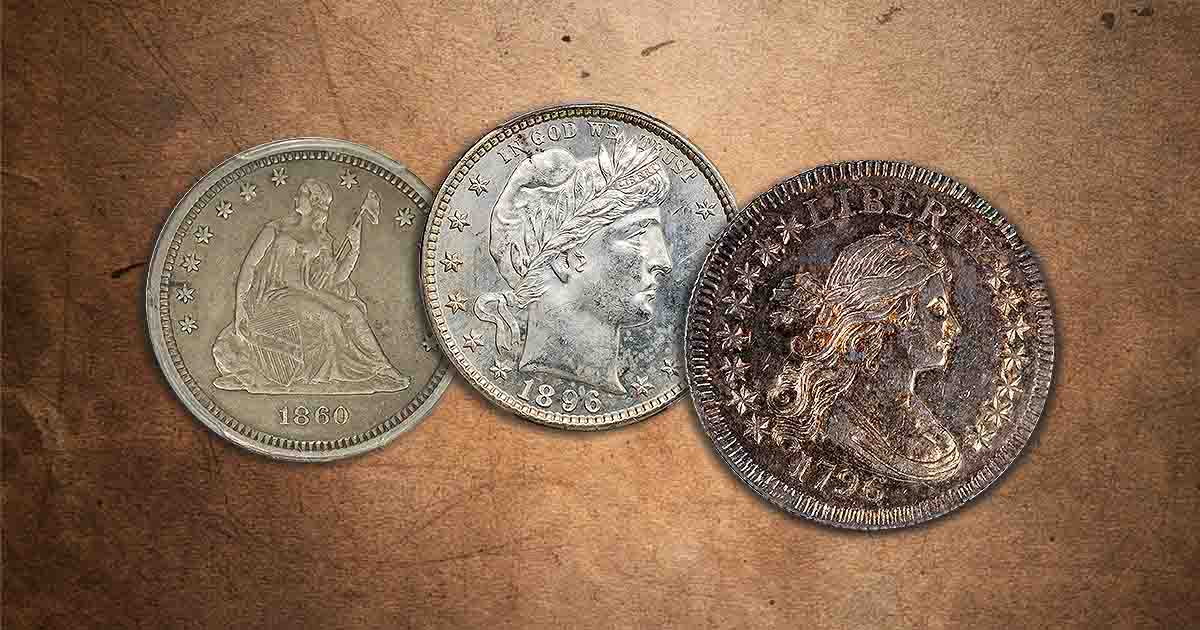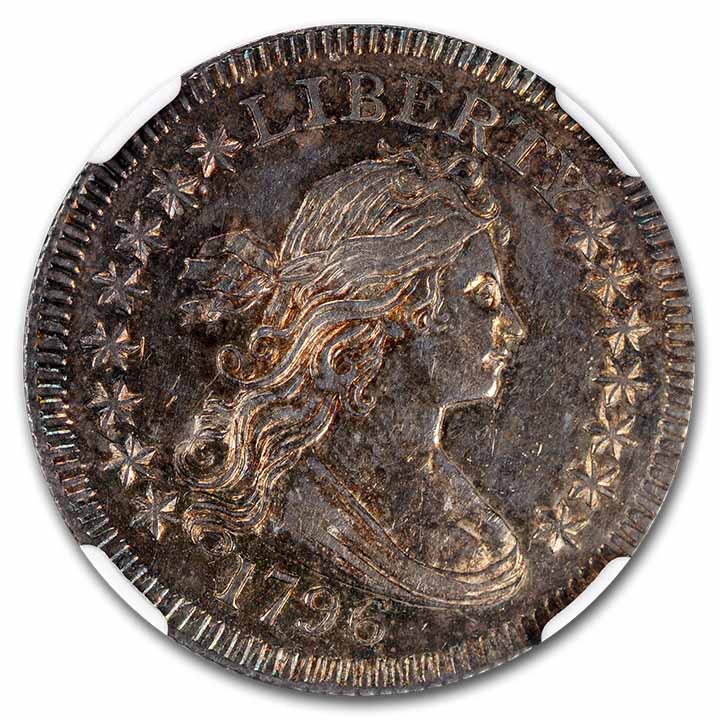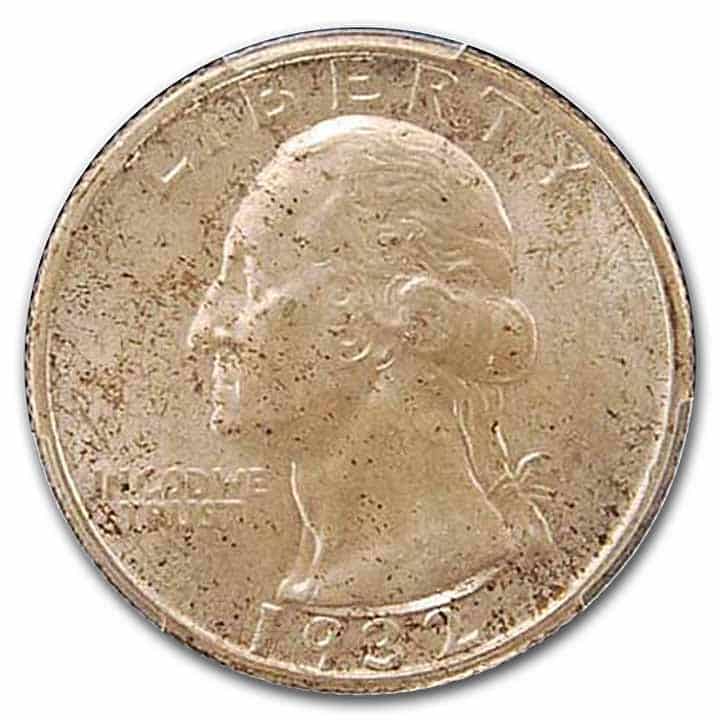
Silver Quarters refer to United States quarters that were minted with a composition of 90% silver and 10% copper. These coins were produced during specific periods in U.S. history, such as the Washington Silver Quarters minted from 1932 to 1964, before the U.S. transitioned to clad coinage due to the rising cost of silver.
Today, silver quarters are sought after by collectors and investors for their historical significance and precious metal content. To learn more about these coins, check out our article on Silver Quarters Throughout History.
Draped Bust Quarter – Small Eagle
1796 Draped Bust Quarter – Small Eagle
The 1796 Draped Bust Quarter with the Small Eagle is a one-year type coin. Only 6,146 coins were struck making this an inaugural year coin and rare date coin. Engraved by Robert Scot with Miss Liberty facing right, surrounded by 15 six-pointed stars, with “LIBERTY” above, and the date below.
The reverse depicts a small eagle with raised wings, inside of a wreath, with “UNITED STATES OF AMERICA,” around the periphery.

Draped Bust Quarter – Heraldic Eagle Reverse
1804 Draped Bust Quarter – Heraldic Eagle Reverse
The 1804 Quarter was the first year of the newly-designed reverse with the heraldic eagle design. A mere 6,738 coins were minted.
1806 6 Over 5, Heraldic Eagle
There are 2 varieties of 1806 dated quarters – normal date, and an 1806 with “6” Over a “5” in the date. The “5” numeral is generally visible under the “6” and to the left.
Capped Bust Quarter – Large Diameter
1815
The 1815 Large Diameter Capped Bust Quarter had a mintage of 89,235 coins struck. These quarters between 1815 and 1828 had a large diameter of 27mm.
1822
This is another Large Diameter Capped Bust Quarter. Only 64,080 coins were struck.
1822 25 Over 50 C
Included in the above mintage is a variety that has the denomination numerals “25” struck over a “50” which was part of the original dies. This variety is rare in all grades. The original “50” digits are visible under the new denomination, “25.”
1823 3 Over 2
The total mintage is 17,800 coins of this date. All of these coins are of this “3” Over “2” variety. This is scarce and valuable in all grades.
1824 4 Over 2
The total mintage is 168,000 and all of these coins are the “4 Over 3” variety.
1827 Original – Curl Base 2 (in 25 C)
Of this original date, only 4,000 coins were struck making it a very rare date. On the original, there is a curl on the base of the “2” in the denomination “25 C.”
1827 Restrike – Square Base 2 (in 25 C)
The restrike differs from the Original strike in that the denomination numeral “2” has a square base instead of the curl base, as in the original,
1828 with the “25” Over “50”
Included in the original mintage of 102,000 coins, there is a small number that has the denomination numerals “25” struck over the original “50,” under the date.
Capped Bust Quarter – Small Diameter
Of these reduced diameter size coins, struck from 1831 through 1838, there are no key dates or varieties.
Liberty Seated Quarter – Variety 1 – No Motto Above Eagle
The coin was re-designed by new US Mint Engraver Christian Gobrecht. The design was struck from 1838 through 1891.
1842-O, with Small Date
Included in the 769,000 coins struck of this date at the New Orleans Mint, the Large Date is the common issue. The Small Date variety is scarce.
1849-O
This date has an unknown mintage but is scarce in all grades.
1853 Recut Date, No Arrows or Rays
The 1853 date is well-known to be the Variety 2 that has Arrows at the date and Rays on the reverse.
Liberty Seated Quarter – Variety 2 – Arrows at Date, Rays on Reverse
There are no scarce dates or scarce varieties of this type.
Liberty Seated Quarter – Variety 3 – Arrows at Date, No Rays on Reverse
1854-O, Huge O
Included in the original mintage of 1,484,000 coins struck, is a small number of coins that displays a much larger than normal “O” mintmark.
Liberty Seated Quarter – Variety 1 – Resumed, but Weight of Variety 2
1860-S
A scarce coin with only 56,000 coins struck, just before the start of the American Civil War. It is scarce in all grades.

1864-S
This rare date has a scant mintage of only 20,000 coins. It is scarce in all grades.
Liberty Seated Quarter – Variety 4 – Motto Above Eagle
1866
The 1866 date had a small mintage of only 16,800 coins making it rare and desirable in all grades, including well-worn specimens, It is the first issue of Liberty Seated Quarters, Variety 4, with the motto “IN GOD WE TRUST” added on a scroll above the eagle on the reverse.
1866-S
The San Francisco Mint struck only 28,000 coins during 1866 making it rare, yet not quite as rare as the Philadelphia coin. The price spikes in Fine grade and above and is even more expensive than the lower mintage 1866 Philadelphia coin.
1867-S
Only 48,000 of these coins were struck at the San Francisco Mint. Rare in all grades of circulation.
1870-CC
A tiny mintage of only 8,340 were struck at the Carson City Mint, which opened in February of that year. Extremely rare due to the low mintage, this quarter dollar is rare in all grades. This date is unknown in Uncirculated grades.
1871-CC
During the second year of operation for the Carson City Mint, the mintage increased but only slightly, to 10,890 quarters struck. Again, it is rare in all grades and there are a few Uncirculated specimens.
1871-S
With only 30,900 coins struck at the San Francisco Mint, this is a scarce date.
1872-CC
The mintage of this date from this mint was only 22,850 coins making it another very scarce Carson City Quarter Dollar.
1872-S
The mintage of this San Francisco issue is only 83,000 coins. This is another scarce issue.

1873, Close 3
There are two varieties of 1873 Philadelphia quarters – a Close 3 and an Open 3. The Close 3 has a mintage of 40,000 while the Open 3 has a much larger mintage of 172,000.
1873-CC
Although US Mint records indicate that 4,000 coins were struck, just six specimens are known to exist, making this coin extremely rare and valuable.
Liberty Seated Quarter – Variety 5 – Arrows at Date
1873-CC
The design changed again to add Arrows at the Date which were added to change the weight from 6.22 to 6.25 grams. Only 12,462 were struck at the Carson City Mint.
Barber Quarter – 1892 – 1916
1896-S
The Liberty Head or Barber Quarter was named after the designer Charles E. Barber. This date saw 188,039 coins struck, while most Barber Quarters had mintages in the millions.

1897-S
With 542,229 for a mintage, the 1897-S is a scarce date, but not a rare date. The prices are increased over common.
1901-S
The 1901-S Barber quarter is the key date of the entire series. It has a small mintage for a Barber Quarter, of only 72,664 coins were struck. It is valuable in all grades, including AG and Good.
1913-S
The 1913-S has the lowest mintage of all Barber Quarters with only 40,000 coins struck. However, this distinction does not make it the most expensive coin in the series. That honor belongs to the 1901-S.
1914-S
This is the last of the scarce date Barber Quarters with a lower mintage of 264,000 coins struck.
Standing Liberty Quarter – 1916 – 1930
Spurred by President Teddy Roosevelt’s Renaissance of American Coinage, the Dime, Quarter, and Half Dollar were all redesigned. The Quarter Dollar was designed by Hermon A. MacNeil. The original design (called Type I) exposes one of Miss Liberty’s breasts as well as having the eagle on the reverse flying near the bottom periphery. Type I coins were struck in 1916 and part of 1917.
The Type II coins were struck in the latter half of 1917 and the design changes remained through 1930. The primary changes included covering Miss Liberty in chainmail, raising the eagle up on the reverse and placing 3 five-pointed stars below the eagle. In 1925, a further modification was made in order to recess the date, which was wearing off after moderate use.
1916 Quarter, Type I
This coin has the lowest mintage in the series with only 52,000 coins struck. Scarce in all grades from AG and up.

1918-S Quarter, Type II, 8 Over 7
This is a rare and popular overdate with the 8 over the 7. It is part of the 11,072,000 that were struck out the total mintage for the normal date.
1921
With a mintage of less than 2 million coins (1,916,000) this is a scarce date even in Good condition.
1923-S
The total mintage of 1,360,000 coins qualifies this as a better date.
1927-S
The total mintage is only 396,000 coins. There are dramatic increases in price in Extremely Fine and higher grades.
Washington Quarter – 1932 – Current
In 1932, the bi-centennial of George Washington’s birth was being celebrated. The decision was made to place his image on the Quarter Dollar. Designers competed to have their design selected. One of the most beautiful designs was created by Laura Gardin Fraser, wife of James Earle Fraser. But there was resistance to having a circulating coin that was actually designed by a woman. She had designed several commemorative coins to that point, but all the other circulating coins were designed by men. So, John Flanagan’s design was selected and became our new quarter.
1932-D Washington Quarter
Although the Philadelphia Mint struck more than 5.4 million coins, the branch mints did not follow suit. The Denver Mint struck 436,800 coins, while the San Francisco Mint struck even fewer.
1932-S
Although the mintage is lower than its D mint counterpart, it is worth less than the D Mint, but it still is considered a key date of this series.
1934 Doubled Die Obverse
No one knows for certain how many of the nearly 32 million 1934 dated coins have this doubling on the obverse, but it certainly is worth looking for as the prices are significantly higher than those without. The doubling is most prominent on the lettering “IN GOD WE TRUST” on the obverse.

1937 Doubled Die Obverse
This is another error coin variety that has value. The doubling is very strong on the date itself.
1942-D Doubled Die Obverse
The doubling is most noticeable on the word “LIBERTY” above Washington’s portrait on the obverse.
1943 Doubled Die Obverse
Again, the doubling on this coin is strongest at the date on the obverse. This particular error coin is much rarer than the other Doubled Die Obverse coins.
1943-S Doubled Die Obverse
The date doubling is the first place to look to verify this variety.
1950-D, D Over S
The D mintmark is strong, but traces of the “S” are visible under magnification.
1950-S S Over D
Likewise, on this “S” mint coin, the D mintmark under the S is strong and visible with magnification.
Statehood Washington Quarters – 1999 – 2008
2004-D Wisconsin Statehood Quarter, Extra Leaf High
While the Statehood Quarter set is generally inexpensive and easy to assemble, there are two scarce coins. Both are varieties of the exact same coin. The 2004-D coin from the Statehood series for the state of Wisconsin. One die has an extra leaf that is higher up on the stalk while the other variety has a lower leaf. The High Leaf is slightly more valuable.


There are normal dies, dies with an extra leaf high and dies with an extra leaf low.
Quarters Dollars Values
| Date | Mintage | Fine | Abt Unc | Ch Unc |
| 1796 Sm Eagle | 6,146 | $27,500 | $60,000 | $175,000 |
| 1804 Heraldic | 6,738 | $10,000 | $52,500 | $180,000 |
| 1806 6/5 | Included | $1,200 | $6,250 | $26,000 |
| 1815 | 89,235 | $600 | $3,500 | $8,500 |
| 1822 | 64,080 | $800 | $3,250 | $12,500 |
| 1822 25/50 C | Included | $18,000 | $45,000 | $85,000 |
| 1823 3/2 | 17,800 | $80,000 | $175,000 | $400,000 |
| 1824 4/2 | 168,000 | $1,850 | $7,750 | $60,000 |
| 1827 Curl Base 2 | 4,000 | $40,000 | $85,000 | $275,000 |
| 1827 Res Sq 2 | Included | $20,000 | $40,000 | $75,000 |
| 1828 25 Over 50 | Included | $2,500 | $14,000 | $100,000 |
| 1842-O Small Dt | Included | $1,600 | $11,000 | $70,000 |
| 1849-O | Unknown | $2,500 | $8,500 | $21,500 |
| 1853 No Arr/Ray | 44,200 | $2,500 | $5,000 | $7,500 |
| 1854-O Huge O | Unknown | $1,350 | $7,500 | $20,000 |
| 1860-S | 56,000 | $3,000 | $16,500 | $75,000 |
| 1864-S | 20,000 | $1,500 | $6,000 | $20,000 |
| 1866 | 16,800 | $1,250 | $2,500 | $3,500 |
| 1866-S | 28,000 | $1,350 | $3,500 | $13,500 |
| 1867-S | 48,000 | $1,150 | $7,250 | $15,000 |
| 1870-CC | 8,340 | $20,000 | $105,000 | —- |
| 1871-CC | 10,890 | $18,000 | $55,000 | $300,000 |
| 1871-S | 30,900 | $2,250 | $5,500 | $10,000 |
| 1872-CC | 22,850 | $4,500 | $21,000 | $150,000 |
| 1872-S | 83,000 | $3,500 | $7,000 | $14,000 |
| 1873 Close 3 | 40,000 | $1,000 | $4,500 | $35,000 |
| 1873-CC V. 4 | 6 Known | —- | $300,000 | $450,000 |
| 1873-CC V. 5 | 12,462 | $13,500 | $50,000 | $150,000 |
| 1896-S | 188,039 | $2,150 | $6,500 | $21,000 |
| 1897-S | 542,229 | $350 | $1,500 | $2,500 |
| 1901-S | 72,664 | $13,500 | $32,500 | $50,000 |
| 1913-S | 40,000 | $4,750 | $12,500 | $18,500 |
| 1914-S | 264,000 | $500 | $1,250 | $2,500 |
| 1916 SLQ Ty 1 | 52,000 | $6,000 | $11,000 | $15,000 |
| 1918-S 8/7 | Unknown | $3,500 | $10,000 | $27,500 |
| 1921 | 1,916,000 | $400 | $1,000 | $2,000 |
| 1923-S | 1,360,000 | $625 | $1,900 | $3,250 |
| 1927-S | 396,000 | $110 | $2,250 | $7,500 |
| 1932-D | 436,800 | $125 | $350 | $1,500 |
| 1932-S | 408,000 | $125 | $250 | $650 |
| 1934 Dbl Die | Unknown | $100 | $600 | $1,700 |
| 1937 Dbl Die Ob | Unknown | $400 | $1,500 | $3,000 |
| 1942-D DDO | Unknown | $250 | $750 | $3,000 |
| 1943 DDO | Unknown | $2,000 | $4,000 | $7,500 |
| 1943-S DDO | Unknown | $150 | $350 | $1,000 |
| 1950-D D Over S | Unknown | $100 | $225 | $750 |
| 1950-S S Over D | Unknown | $150 | $250 | $500 |
| 2004-D WI Hi Lf | Unknown | — | — | $175 |
| 2004-D WI Lo Lf | Unknown | — | — | $150 |





